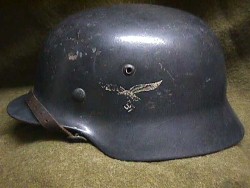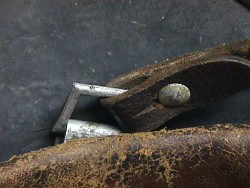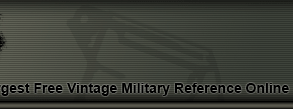
WWII German Luftwaffe Double Decal M-35 Helmet -
Stahlhelm is German for "steel helmet". The Imperial German Army began to replace the traditional
boiled-leather Pickelhaube (spiked combat helmet) with the Stahlhelm during the First World War
in 1916. The term Stahlhelm refers both to a generic steel helmet, and more specifically to the
distinctive German design.
In 1934 tests began on an improved Stahlhelm, whose design was a development of the World War I
models. The Eisenh�ttenwerke company of Thale carried out prototype design and testing, with Dr.
Friedrich Schwerd once again taking a hand.
The new helmet was pressed from sheets of molybdenum steel in several stages. The size of the
flared visor and skirt was reduced, and the large projecting lugs for the obsolete armour shield
were eliminated. The ventilator holes were retained, but were set in smaller hollow rivets mounted
to the helmet's shell. The edges of the shell were rolled over, creating a smooth edge along the
helmet. Finally, a completely new leather suspension, or liner, was incorporated that greatly
improved the helmet's safety, adjustability, and comfort for each wearer. These improvements made
the new M1935 helmet lighter, more compact, and more comfortable to wear than the previous
designs.
The helmet featured here is a German Air Force M-35 style WWII helmet. With double decals.
one showing the Luftwaffe eagle, the other the national colors. The body of the helmet is Of gray
color. Complete with a leather chin strap. The edges of the helmet are rolled.


|
The modern German helmet saw its birth during World War One. Its design was so advanced
for the time that the German government saw it fit for the same basic design to be re-employed
during World War Two.
The German helmet of World Wat Two has become one of the most recognizable silhouttes of war.
The helmetss of the Third Reich came in a variety of designs. There were approximatelly
9 different types developed. Even the non-military helmets often displayed the
swastika as a means to show support of the Nazi party. The helmet was constructed of a
combination of metal and leather.
|
|


The liner in this example is almost complete. Of leather
construction. Attached to the helmet via the use of an aluminum circle riveted
to the body of the helmet. A string that would hold the leather flaps
together is missing. Tightening and loosening the string will adjust the height of
the helmet, controlling how it sits on the soldier's head.
The back of the helmet has been stamped. Information found in the stamps include the helmet
size, manufacturer, year of production, etc. It is important to note that not all the
helmets were stamped.


Some of the helmets have markings stamped in the inside of the rim. The markings provide information
such as the serial number, name of manufacturer, helmet size, etc. A
markings guide has been provided to help
the collector and enthusiast gain a better understanding of their meaning. It is important to
note that not all possibilities of markings are covered in that section.

WWII German helmets are currently being
reproduced.
It is becoming more difficult to be able to tell the fake ones from the real ones because
the quality of the reproductions is improving. The collector must become familiarized with
the construction style and materials employed in the manufacturing of this headgear.
Attention to the details is critical in order to be able to determine the authenticity of
the collectible.
If you have an interest is seeing other American military headgear, you can do so by
going to our WWII German helmets
identification guide. Where we cover Army, Navy, Luftwaffe and other organizations.
|





